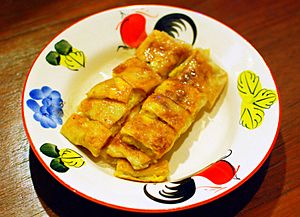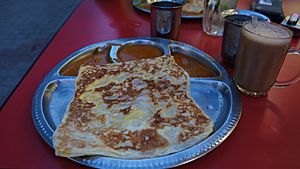Roti facts for kids
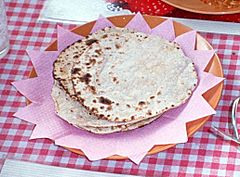
A flat roti from India, also known as chapati
|
|
| Alternative names | Ruti |
|---|---|
| Type | Flatbread |
| Place of origin | Indian subcontinent |
| Created by | Indus Valley civilization |
| Main ingredients | Atta flour |
| Variations | Chapati, Bajra Roti, Jowar Roti, Chawal ki Roti Makki ki roti, Rumali roti, Tandoori roti, Wrap roti, Roti canai, Paratha, Bhakar |
Roti (also known as chapati) is a round, flat bread that comes from the Indian subcontinent. It's a very popular food in many countries, including India, Sri Lanka, Pakistan, Nepal, Bangladesh, and many more around the world.
Roti is made from whole wheat flour, which is traditionally called gehu ka atta. This flour is mixed with water to make a dough. What makes roti special is that it's unleavened. This means it doesn't use yeast or other things to make it rise, unlike breads like Naan. Just like many other breads, roti is a main food that people eat with other dishes.
What Does "Roti" Mean?
The word roti comes from an old Indian language called Sanskrit. In Sanskrit, the word rotikā means "bread."
How to Make Roti
To make roti, the dough is rolled out with a rolling pin. This makes flat, round pieces. Sometimes, people use a special round, flat board called a roti board for this.
Different Kinds of Roti
-
Plain roti paratha
-
A roti wrap with boiled egg and smoked chicken in the Netherlands
-
Indian thali with chapati
-
A chef preparing rumali roti in India
-
Roti stuffed with bananas
Many different kinds of flatbreads and rotis are found all over the world. The traditional roti comes from the Indian subcontinent. People usually eat it with cooked vegetables or curries. It's like a way to pick up the food!
Roti is most often made from wheat flour. It's cooked on a flat or slightly curved iron pan called a tawa. In the past, rotis were also made from other flours like millet, maize (corn), jowar, bajra, and even rice.
Roti in India and Nearby Countries
Tandoori roti is cooked in a special clay oven called a tandoor. The flattened dough is stuck to the inside wall of the hot oven, where it bakes very quickly.
Chapatis are made from whole-wheat flour called atta. This flour is mixed with water, cooking oil, and sometimes salt to make a dough. Chapatis are cooked on a tawa. In some places, like Punjab, chapatis are called phulka. In Sindh, they are called maani.
Roti in Sri Lanka
In Sri Lanka, there's a type of roti called pol roti. This one is made with wheat flour and/or kurakkan flour, mixed with shredded coconut. Sometimes, people add chopped green chilies and onions to the mix before cooking. Pol roti is usually thicker and harder than other rotis. It's often eaten with curries or spicy pastes called sambol or lunu miris. It's considered a main meal.
Another popular roti in Sri Lanka is kottu roti. This is made from paratha or godamba roti that are cut into small pieces. These pieces are then mixed and chopped on a hot pan with fried vegetables, onions, eggs, and cooked meat or fish. The sound of it being chopped can be heard from far away! Kottu roti is often served as a fast food dish.
Godamba roti is another type found in Sri Lanka. Plain godamba roti is eaten with curry. It can also be wrapped around a tasty filling.
Roti in the Caribbean
Roti is very popular across the Caribbean, especially in countries like Trinidad and Tobago, Guyana, Suriname, and Jamaica. It was first brought to these islands by workers from the Indian subcontinent. Now, it's a main part of the food in these countries.
In the Caribbean, people usually eat roti with different curries and stews. The traditional way to eat it is to tear off a piece of roti by hand and use it to soak up the sauce and meat from the curry.
The roti wrap is a very popular street food in the Caribbean. It's when the roti is folded around a tasty filling, like a burrito. This wrap started in southern Trinidad in the 1940s. It was created by Sackina Karamath, who later started the Hummingbird Roti Shop. The wrap was handy because people could eat it faster and without getting their hands messy.
In Trinidad and Tobago, you can find many kinds of wrapped rotis. Fillings include chicken, conch, goat, beef, and shrimp. Vegetables like potato, pumpkin, and spinach can also be added. Popular sauces include pepper sauce (hot sauce) and mango chutney. The roti wrap became popular very quickly and spread across the Caribbean. Now, people often just call the wrap "a roti." The flatbread itself is sometimes called a "roti skin" or "roti shell."
Caribbean-style roti is mostly made from wheat flour, baking powder, salt, and water. It's cooked on a tawa. Some rotis are also made with ghee (clarified butter) or butter.
Roti in Trinidad and Tobago
| Food | Image | Description |
|---|---|---|
| Sada roti | This is a plain roti made from white flour. It's the simplest and most common roti in Trinidad. People often eat it for breakfast with different curried meats and vegetables. | |
| Paratha roti | 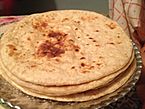 |
This roti has layers and is made with butter, usually ghee. Ghee is rubbed on both sides, then it's cooked on a tawa. This makes the roti crispy on the outside. When it's almost done, the cook gently beats the roti on the tawa to make it light and flaky. Paratha roti is richer and more flavorful than plain roti. It's eaten with almost anything, especially curries, stews, or even fried eggs and tea. In Trinidad, parathas are sometimes called "buss-up shut" because they look like a torn shirt. |
| Puri | 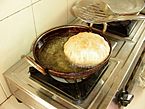 |
This roti is made by rolling out two layers of dough together. After rolling, it's fried directly in hot oil. Some people half-cook it on a tawa first to make it soak up less oil. This type of roti is eaten with a special sweet dish called halva when a baby is born. |
| Dhalpuri | This roti has a filling made from ground yellow split peas, cumin, garlic, and pepper. The split peas are boiled and then ground. The cumin is toasted and also ground. This filling is put inside the roti dough and sealed. When the roti is rolled flat, the filling spreads out inside. It's cooked on the tawa with oil. Dhalpuri is often eaten with various curries and is the top choice for making wrap rotis. | |
| Wrap roti | 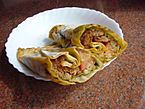 |
A popular wrap made by folding meat and vegetable curries inside a dhalpuri roti. The curry often has potatoes and/or chickpeas as fillers, along with the meat. Vegetarian options are also common. Popular fillings include curried chicken, goat, conch, duck, beef, shrimp, and vegetables. People often add sauces like pepper sauce and mango chutney. |
| Aloo puri / potato puri | This roti is like a dhalpuri, but it uses aloo (potato) instead of dhal. The potato is boiled and mashed, then spices are added before it's sealed in the dough. This potato filling is also used in dishes like aloo pie. |
Roti in Guyana
Dosti roti is common in Guyana. A small amount of fat is added to each piece of dough before it's rolled out. This makes the roti softer. Usually, vegetable oil is used, but butter or margarine can also be used. Ghee is used for special occasions. After cooking, the roti is usually clapped by hand or gently beaten while it's still hot. This makes it soft but keeps it whole.
- A good roti in Guyana is very soft and has layers, almost like pastry.
- The type of roti depends on what's added to the dough. There are dhalpuri, aloo (potato) roti, and even sugar roti (often made for kids).
- In Guyana, a thin, flat dough that is deep-fried in ghee is called a puri. So, a dhalpuri is not really a puri in Guyana.
- Another food like roti is called bake or floats. These are made with butter or margarine and are quicker to make than roti. They are usually made in the mornings. The dough is rolled out and cut into shapes or small rounds. Guyanese bakes are fried, but bakes from other Caribbean places can be baked in an oven. Bakes are often eaten for breakfast or dinner with stewed saltfish or eggs. In Trinidad and Tobago, a "bake and shark" is a famous street-food sandwich where fried shark is put between two halves of a sliced bake with local sauces.
Roti in Suriname
In Suriname, "roti" mostly means dhalpuri or aloo puri. It's often eaten with curried chicken. Like in Trinidad, "roti" can also mean the stuffed roti wrap. This dish is usually eaten by hand.
Many people from Suriname moved to the Netherlands in the 1970s. Because of this, roti became a popular take-out dish there. It usually includes chicken curry, potatoes, a boiled egg, and vegetables like kousenband (yardlong bean). Another version has shrimp and eggplant. The meat, gravy, potatoes, egg, and vegetables are served on a plate, with the aloo puri folded on top.
Roti in Southeast Asia
In Indonesia and Malaysia, the word "roti" means all kinds of bread, including Western-style bread and traditional Indian breads.
In Thailand, "โรตี" (roti) refers to a type of paratha made with maida flour. This is known as roti maryam or roti cane in Indonesia, roti canai in Malaysia, and roti prata in Singapore.
In Cambodia, "រ៉ូទី" (roti) is a sweet street food. It's like a mix between a crêpe and a paratha.
Roti in South Africa
Roti first came to South Africa with Indian immigrants in the 1800s. It then became a part of the food in Durban. Indian communities in South Africa eat it a lot, either as a flat bread or as a wrap with local curries.
Roti in Mauritius
Just like in other countries where people from India moved, roti was brought to Mauritius by Indian workers in the 1800s. Since then, it has become a main food in Mauritian cuisine and a common street food.
"Roti" usually means farata in Mauritius. This is a pancake made of wheat flour and water. Other types include dholl puri, which has layers and is stuffed with boiled and ground split peas. There's also ti puri, a smaller fried roti usually served with seven different curries.
Roti in Iran
In Iran, two types of roti are called khaboos and lavash. Khaboos is made almost exactly like Indian roti, and both are very similar to other rotis.
Roti in North America
Roti shops are now common in many places, including Trinidad and Tobago, Guyana, Suriname, Jamaica, the United States, Canada, the United Kingdom, and the Netherlands.
Because Canada has many immigrants from South Asia and the Caribbean, roti and its different types are popular there. When Indo-Caribbeans moved to cities like Toronto, New York City, Miami, Los Angeles, and Montreal, they brought the wrapped version of roti with them. A special kind of roti in Toronto is called the "East Indian roti," which is a version of the stuffed roti from the West Indies.
See also
 In Spanish: Roti para niños
In Spanish: Roti para niños













